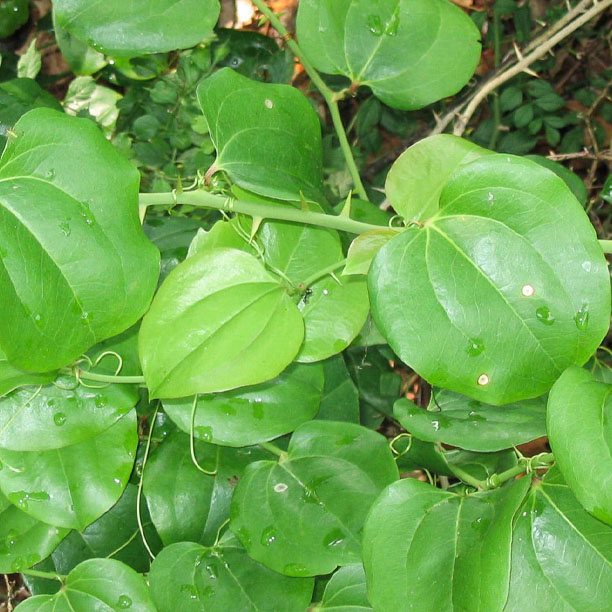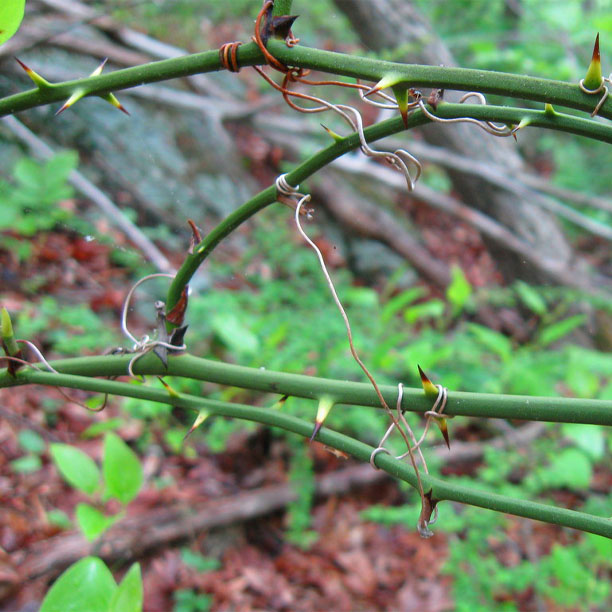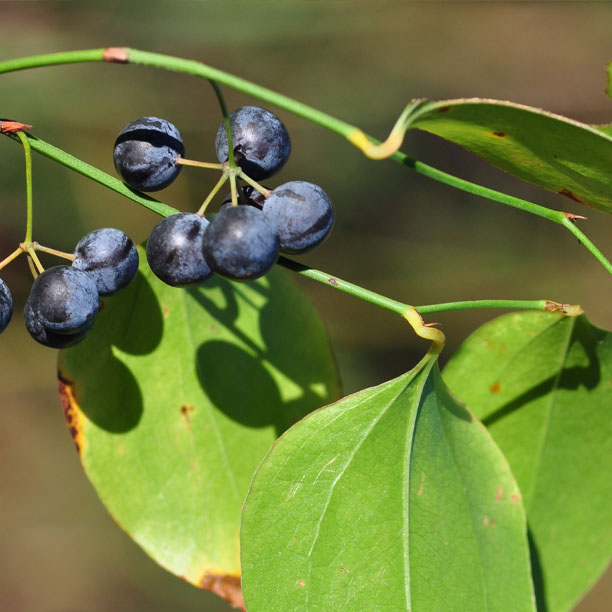Greenbrier
How To Identify
Greenbriar is an evergreen, thorny vine that can send shoots up, standing on their own without support, for as high as 3 feet. It is more often found climbing other vines, trees or plants using its tendrils and can reach lengths of about 20 feet.
The leaves can be oval to heart-shaped and can be from solid light green to mottled dark green. They can be from super shiny to matte. So, neither leaf shape, nor color are the best way to identify this plant.
Two ways to positively identify greenbrier are; all of the leaves’ primary veins come out from a central point located where the leaf meets the leaf stem. The most important identification feature for greenbrier is that they are the only North American vine to have both thorns and tendrils. So, if you think you’ve found a greenbrier, trace it back on the vine until you can see both a thorn and a tendril along with all primary leaf veins coming from the leaf stem, you should be good.



Benefits
The leaves, shoots and tendrils are high in protein, fiber, carbohydrates and fats. They also contains calcium, iron, magnesium, potassium, zinc and manganese as well as vitamin E.
The health benefits are awesome. Greenbrier’s anti-inflammatory properties help with conditions such as arthritis, gout, muscle and joint aches. It possesses the compounds parillin, saponins and flavonoids that ease flare ups in body and ease discomfort as well as pain.
The berries of greenbrier possess antibacterial properties that increase immunity and help prevent infection and improve the body’s response to illness such as colds and flues.
The root of greenbrier contains antioxidants, sterol and flavonoids which help nullify free radicals and can possibly help prevent cancer. It also helps to increases libido in men and women.
The leaves, shoots and tendrils have antibacterial properties which help maintain skin appearance and reduces the appearance of wrinkles and age spots when eaten or applied to the skin. Greenbrier is considered to be diuretic which promotes urination and helps to detoxify and purify the body by eliminating the presence of excess salts, fats, water and toxins. In addition, it purifies the blood and increases the maintenance of health by lowering the strain on kidneys and liver. It can also help with weight loss as it helps to restrain appetite and food cravings.
How To Find
Greenbrier is a native plant that grows from Canada to Florida and west to Texas and Oklahoma. It has a small yellowish green blossom on the vine from May to June and its blue-black fruit can be seen from fall through winter, or until the wildlife has eaten it.
Greenbriers will most often be found near water sources such as steams, ponds and swampy areas but can also be found in slightly dryer areas as long as there is plenty of shade.
Gathering
If berries are found and have ripened to a dark blue-black, they can simply be picked and eaten raw or collected.
The tender new greenbrier vine growth can be snapped off the vine and eaten raw or collected to be cooked later. Just make sure it is new growth and hasn’t aged to the point that the thorns have hardened. At this point the vein will be too woody. The leaves are also edible in the early spring – early summer but they get tougher in the summer to fall. The leaves also have a pleasant taste, similar to a lemony asparagus and can be eaten raw or collected and cooked later.
How To Use
The berries are delicious fresh, but they also make excellent preserves, pies, juice and syrup. It is best to separate the 1-4 seeds inside.
The tender shoots, leaves and tendrils can also be eaten fresh, added to salads, soups and stews. They can also be boiled like spinach or roasted like asparagus.
The leaves and/or roots can be used fresh or dried to make a medicinal tea. Our preferred method is to dry the leaves for use with tea. To prepare a cup, steep about 2 Tbsp. of dried leaves by pouring boiling water over them and allowing to infuse for 15 – 20 minutes, then strain and serve or simply stuff a tea ball and steep in your favorite cup or mug.
With similar but more concentrated benefits than tea, a tincture can be made by stuffing a jar (or other container) with fresh leaves and then toping it off with vodka. Allow this to sit on a window sill or another sunny spot for at least two weeks and then filter the liquid and discard the leaves. This liquid tincture can then be taken, 1/4–3/4 teaspoon (1–4 ml) two times per day.
Preservation
The berries can be water bath canned as pie filling, jelly or jam. They can be frozen whole or as a puree. They are best frozen immediately after being picked. Do not wash them first. If you do, they will burst open and turn mushy when frozen. The easiest way to freeze the berries is to spread them out on a cookie sheet and freeze them before bagging them up in freezer bags. Do not thaw the berries before using them in cooking or baking. Freezing them in a single layer keeps the berries from clumping together in the freezer bag. They can also be dehydrated or freeze dried and then powdered. To dehydrate them, place them in a dehydrator at 135°F for 8 to 18 hours. Time will vary with each dehydrator, size of berries and with temperature and humidity levels in your house.
To preserve the leaves, shoots, tendrils and root place them into separate paper bags, or on a screen (window screen or similar) and allow them to dry in a dry dark place with good airflow. They can also be dehydrated using very low or no heat in a standard dehydrator or freeze dried. Oven drying isn’t recommended as the heat can damage the medicinal benefits. Another method of preserving the leaves is to make a tincture as described above. Because of the alcohol, tinctures can last on the shelf for years.